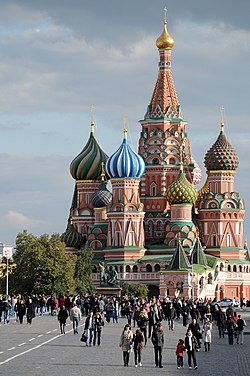
Back الدين في روسيا Arabic Рәсәйҙә дин Bashkir Рэлігія ў Расеі BE-X-OLD Religion in Russland German Θρησκεία στη Ρωσία Greek Religión en Rusia Spanish دین در روسیه Persian Uskonto Venäjällä Finnish Religion en Russie French דת ברוסיה HE
Religion in Russia (2024 estimate)[1][2]
Russian Orthodoxy (61.8%)
Other Christian (2.6%)
Islam (9.5%)
Other religions (1.4%)
No religion (21.2%)
Undeclared (3.5%)

Orthodox Christianity is the most widely professed religion in Russia, with significant minorities of non-religious people and adherents of other faiths.[3]
The constitution of Russia recognises the right to freedom of conscience and creed to all the citizenry, the spiritual contribution of Orthodox Christianity to the history of Russia, and respect to "Christianity, Islam, Buddhism, Judaism and other religions and creeds which constitute an inseparable part of the historical heritage of Russia's peoples",[4] including ethnic religions or paganism, either preserved, or revived.[5]
- ^ "Русская православная церковь" (in Russian). Фонд Общественное Мнение, ФОМ (Public Opinion Foundation). 2 May 2024. Archived from the original on 16 May 2024. Retrieved 10 June 2024.
- ^ "Русская православная церковь" (in Russian). Фонд Общественное Мнение, ФОМ (Public Opinion Foundation). 2 May 2024. Archived from the original on 3 May 2024. Retrieved 10 June 2024.
- ^ "Арена: Атлас религий и национальностей" [Arena: Atlas of Religions and Nationalities] (PDF). Среда (Sreda). 2012.See also the results' main interactive mapping and the static mappings: "Religions in Russia by federal subject" (Map). Ogonek. 34 (5243). 27 August 2012. Archived from the original on 21 April 2017. The Sreda Arena Atlas was realised in cooperation with the All-Russia Population Census 2010 (Всероссийской переписи населения 2010), the Russian Ministry of Justice (Минюста РФ), the Public Opinion Foundation (Фонда Общественного Мнения) and presented among others by the Analytical Department of the Synodal Information Department of the Russian Orthodox Church. See: "Проект АРЕНА: Атлас религий и национальностей" [Project ARENA: Atlas of religions and nationalities]. Russian Journal. 10 December 2012.
- ^ Bourdeaux 2003, p. 47.
- ^ Fagan 2013, p. 127.